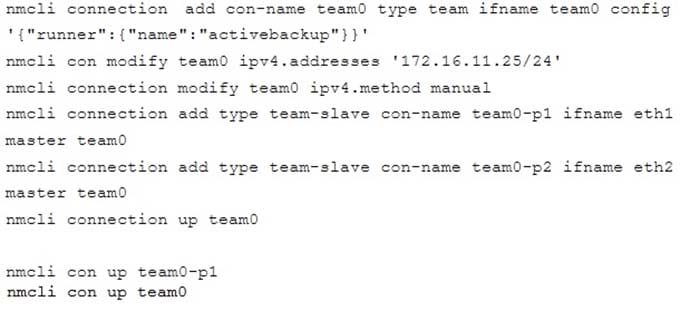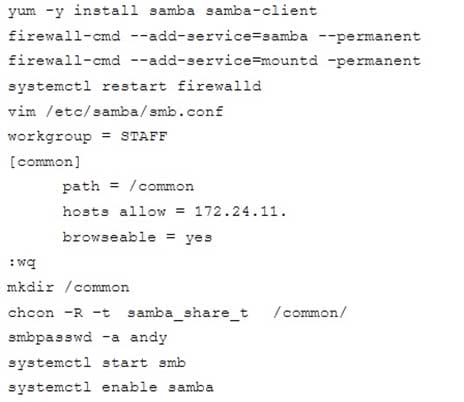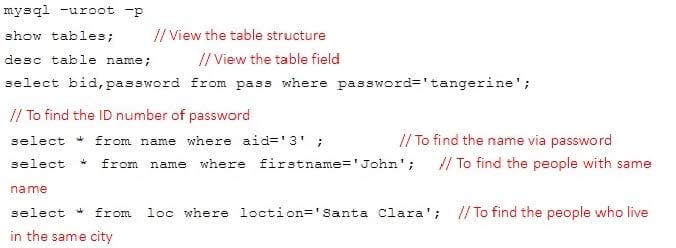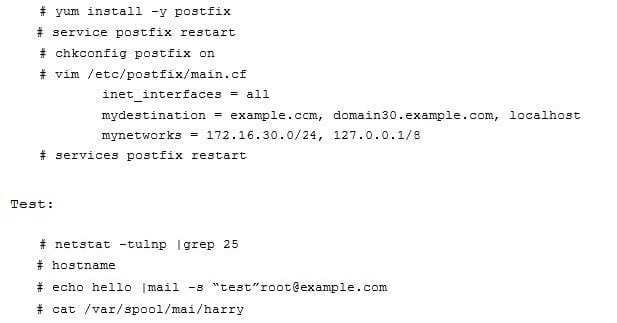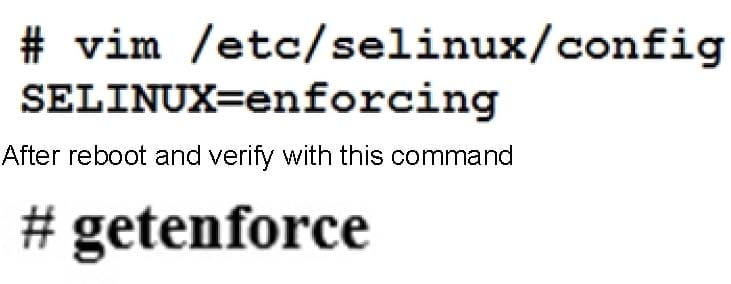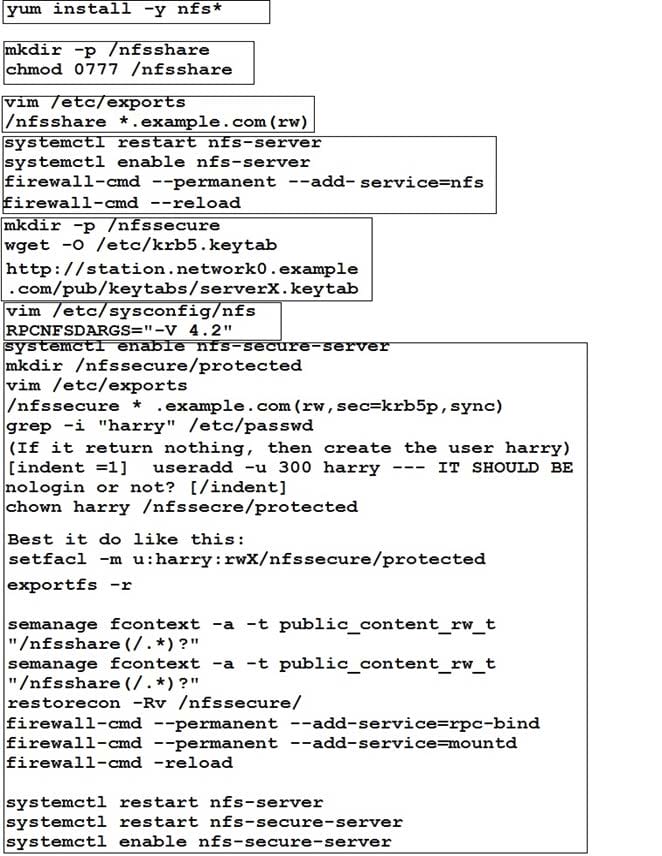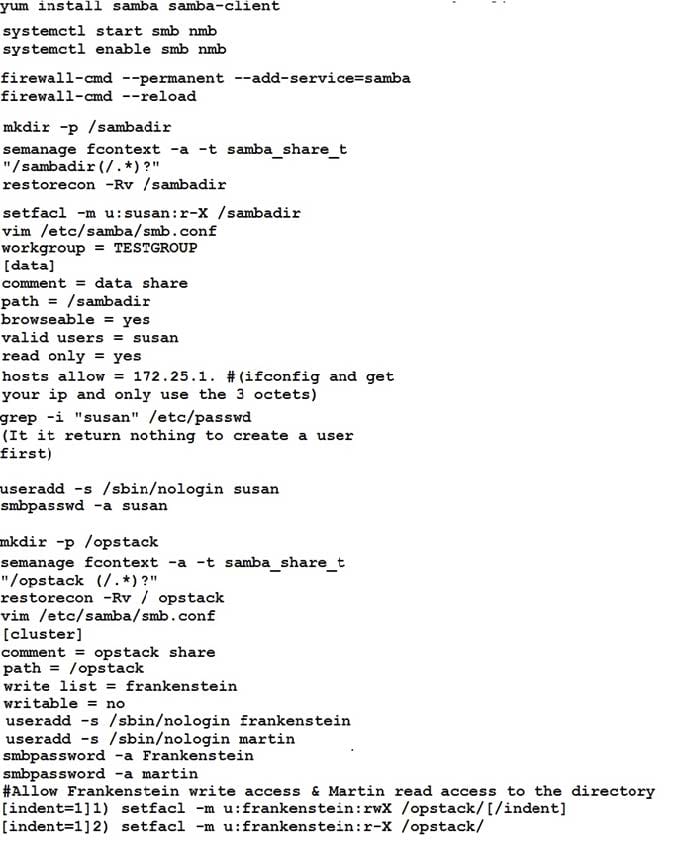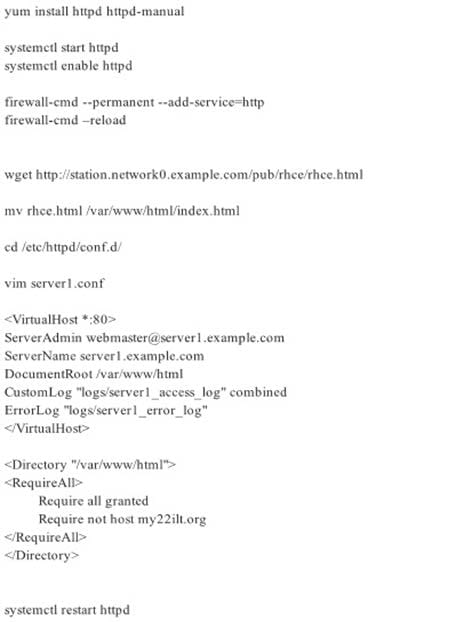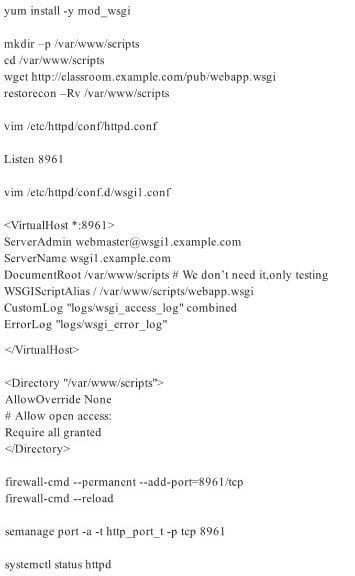EX300 Online Practice Questions and Answers
SIMULATION
RHCE Test Configuration Instructions
Information for the two systems you will use in test is the following:
system1.group3.example.com: is one of the main sever. system2.group3.example.com: mainly used as a client. Password for both of the two systems is atenorth System's IP is provided by DHCP, you can regard it as normal, or you can reset to Static IP in accordance
with the following requirements:
system1.group3.example.com: 172.24.3.5system2.group3.example.com: 172.24.3.10
The subnet mask is 255.255.255.0
Your system is a member of DNS domain group3.example.com. All systems in DNS domain group3.example.com are all in subnet 172.24.3.0/255.255.255.0, the same all systems in this subnet are also in group3.example.com, unless specialized, all network services required to be configured can be accessed by systems of domain group3.
host.group3.example.com provides a centralized authentication service domain GROUP3.EXAMPLE.COM, both system1 and system2 have already been pre-configured to be the client for this domain, this domain provides the following user account:

Firewall is enabled by default, you can turn it off when deemed appropriate, other settings about firewall may be in separate requirements.
Your system will be restarted before scoring, so please ensure that all modifications and service configurations you made still can be operated after the restart without manual intervention, virtual machine instances of all examinations must be able to enter the correct multi-user level after restart without manual assistance, it will be scored zero if the test using virtual machine system cannot be restarted or be properly restarted.
Corresponding distribution packages for the testing using operating system Red Hat Enterprise Linux version can be found in the following link: http://server1.group3.example.com/rhel
Part of the requirements include host security, ensure your host security limit does not prevent the request to allow the host and network, although you correctly configured the network service but would have to allow the host or network is blocked, this also does not score.
You will notice that some requirements which clearly do not allow services be accessed by service domain my133t.org, systems of this domain are in subnet 172.25.1.0/252.255.255.0, and systems of these subnets also belong to my 133t.org domain.
PS: Notice that some test questions may depend on other exam questions, for example, you might be asked to perform a series of restrictions on a user, but this user creation may be required in other questions. For convenient identification, each exam question has some radio buttons to help you identify which questions you have already completed or not completed. Certainly, you do not need to care these buttons if you don't need them.
Configure Link Aggregation
Configure a link between systeml.group3.example.com and system2. group3.example.com as required: This link uses interfaces eth1 and eth2 This link still can work when one interface failes This link uses the following address 172.16.3.20/255.255.255.0 on systeml This link uses the following address 172.16.3.25/255.255.255.0 on system2 This link remains normal after the system is restarted
SIMULATION
RHCE Test Configuration Instructions
Information for the two systems you will use in test is the following:
system1.group3.example.com: is one of the main sever. system2.group3.example.com: mainly used as a client.
Password for both of the two systems is atenorth
System's IP is provided by DHCP, you can regard it as normal, or you can reset to Static IP in accordance with the following requirements:
system1.group3.example.com: 172.24.3.5system2.group3.example.com: 172.24.3.10
The subnet mask is 255.255.255.0
Your system is a member of DNS domain group3.example.com. All systems in DNS domain group3.example.com are all in subnet 172.24.3.0/255.255.255.0, the same all systems in this subnet are also in group3.example.com, unless specialized, all network services required to be configured can be accessed by systems of domain group3.
host.group3.example.com provides a centralized authentication service domain GROUP3.EXAMPLE.COM, both system1 and system2 have already been pre-configured to be the client

for this domain, this domain provides the following user account:
Firewall is enabled by default, you can turn it off when deemed appropriate, other settings about firewall may be in separate requirements.
Your system will be restarted before scoring, so please ensure that all modifications and service configurations you made still can be operated after the restart without manual intervention, virtual machine instances of all examinations must be able to enter the correct multi-user level after restart without manual assistance, it will be scored zero if the test using virtual machine system cannot be restarted or be properly restarted.
Corresponding distribution packages for the testing using operating system Red Hat Enterprise Linux version can be found in the following link: http://server1.group3.example.com/rhel
Part of the requirements include host security, ensure your host security limit does not prevent the request to allow the host and network, although you correctly configured the network service but would have to allow the host or network is blocked, this also does not score.
You will notice that some requirements which clearly do not allow services be accessed by service domain my133t.org, systems of this domain are in subnet 172.25.1.0/252.255.255.0, and systems of these subnets also belong to my 133t.org domain.
PS: Notice that some test questions may depend on other exam questions, for example, you might be asked to perform a series of restrictions on a user, but this user creation may be required in other questions. For convenient identification, each exam question has some radio buttons to help you identify which questions you have already completed or not completed. Certainly, you do not need to care these buttons if you don't need them.
Share directories via SMB.
Configure the SMB service on the system1.
Your SMB server must be a member of the STAFF Working Group.
Share the folder /common and the name must be common.
Only clients of domain11.example.com can access the common share.
Common must be able to browse.
User Andy must be able to read the content of the share, if necessary, verification code is redhat.
SIMULATION
RHCE Test Configuration Instructions
Information for the two systems you will use in test is the following:
system1.group3.example.com: is one of the main sever. system2.group3.example.com: mainly used as a client.
Password for both of the two systems is atenorth
System's IP is provided by DHCP, you can regard it as normal, or you can reset to Static IP in accordance with the following requirements:
system1.group3.example.com: 172.24.3.5system2.group3.example.com: 172.24.3.10
The subnet mask is 255.255.255.0
Your system is a member of DNS domain group3.example.com. All systems in DNS domain group3.example.com are all in subnet 172.24.3.0/255.255.255.0, the same all systems in this subnet are also in group3.example.com, unless specialized, all network services required to be configured can be accessed by systems of domain group3.
host.group3.example.com provides a centralized authentication service domain GROUP3.EXAMPLE.COM, both system1 and system2 have already been pre-configured to be the client
for this domain, this domain provides the following user account:

Firewall is enabled by default, you can turn it off when deemed appropriate, other settings about firewall may be in separate requirements.
Your system will be restarted before scoring, so please ensure that all modifications and service configurations you made still can be operated after the restart without manual intervention, virtual machine instances of all examinations must be able to enter the correct multi-user level after restart without manual assistance, it will be scored zero if the test using virtual machine system cannot be restarted or be properly restarted.
Corresponding distribution packages for the testing using operating system Red Hat Enterprise Linux version can be found in the following link: http://server1.group3.example.com/rhel
Part of the requirements include host security, ensure your host security limit does not prevent the request to allow the host and network, although you correctly configured the network service but would have to allow the host or network is blocked, this also does not score.
You will notice that some requirements which clearly do not allow services be accessed by service domain my133t.org, systems of this domain are in subnet 172.25.1.0/252.255.255.0, and systems of these subnets also belong to my 133t.org domain.
PS: Notice that some test questions may depend on other exam questions, for example, you might be asked to perform a series of restrictions on a user, but this user creation may be required in other questions. For convenient identification, each exam question has some radio buttons to help you identify which questions you have already completed or not completed. Certainly, you do not need to care these buttons if you don't need them.
Create a script to add users
Create a script named /root/mkusers on the system1, this script can achieve to add local users for the system1, and user names of these users are all from a file which contains the usernames list, and meet the following requirements at the same time:
1. This script is required to provide a parameter; this parameter is the file which contains the usernames list
2. This script need provide the following message: Usage:/root/mkusers if it does not provide a parameter, then exit and return the corresponding value
3. This script need provide the following message: Input file not found if it provides a name that does not exist, then exit and return the corresponding value
4. Create a user shell log into /bin/false
5. This script does not need to set password for users
6. You can get the usernames list from the following URL as a test: http://rhgls. domain11.example.com/materials/ userlist
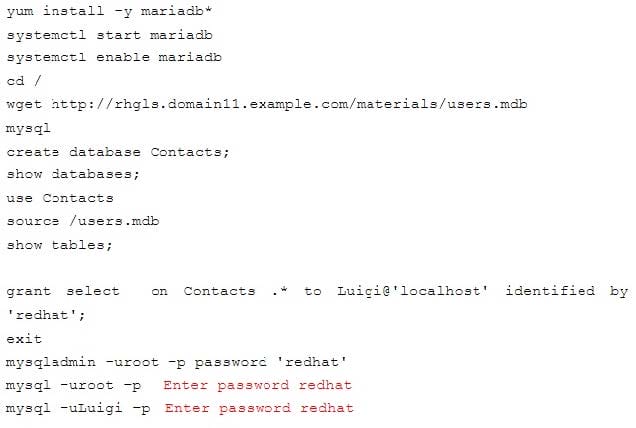
SIMULATION
RHCE Test Configuration Instructions
Information for the two systems you will use in test is the following:
system1.group3.example.com: is one of the main sever. system2.group3.example.com: mainly used as a client.
Password for both of the two systems is atenorth
System's IP is provided by DHCP, you can regard it as normal, or you can reset to Static IP in accordance with the following requirements:
system1.group3.example.com: 172.24.3.5system2.group3.example.com: 172.24.3.10
The subnet mask is 255.255.255.0
Your system is a member of DNS domain group3.example.com. All systems in DNS domain group3.example.com are all in subnet 172.24.3.0/255.255.255.0, the same all systems in this subnet are also in group3.example.com, unless specialized, all network services required to be configured can be accessed by systems of domain group3.
host.group3.example.com provides a centralized authentication service domain GROUP3.EXAMPLE.COM, both system1 and system2 have already been pre-configured to be the client

for this domain, this domain provides the following user account:
Firewall is enabled by default, you can turn it off when deemed appropriate, other settings about firewall
may be in separate requirements.
Your system will be restarted before scoring, so please ensure that all modifications and service configurations you made still can be operated after the restart without manual intervention, virtual machine instances of all examinations must be able to enter the correct multi-user level after restart without manual assistance, it will be scored zero if the test using virtual machine system cannot be restarted or be properly restarted.
Corresponding distribution packages for the testing using operating system Red Hat Enterprise Linux version can be found in the following link: http://server1.group3.example.com/rhel
Part of the requirements include host security, ensure your host security limit does not prevent the request to allow the host and network, although you correctly configured the network service but would have to allow the host or network is blocked, this also does not score.
You will notice that some requirements which clearly do not allow services be accessed by service domain my133t.org, systems of this domain are in subnet 172.25.1.0/252.255.255.0, and systems of these subnets also belong to my 133t.org domain.
PS: Notice that some test questions may depend on other exam questions, for example, you might be asked to perform a series of restrictions on a user, but this user creation may be required in other questions. For convenient identification, each exam question has some radio buttons to help you identify which questions you have already completed or not completed. Certainly, you do not need to care these buttons if you don't need them.
Database Query
Use database Contacts on the system1, and use the corresponding SQL to search and answer the following questions:
1.
What's the person name whose password is solicitous?
2.
How many people's names are John and live is Shanghai at the same time?
SIMULATION
Via nfs service share the /common directory in your system, just doing ONE share in example.com domain.
SIMULATION
Given the kernel of a permanent kernel parameters: sysctl=1. It can be shown on cmdline after restarting the system. Kernel of /boot/grub/grub.conf should be a34dded finally, as:
SIMULATION
Configure an email server domain30.example.com, and it requests to send and receive emails from the local server or the user harry can send or receive emails from network. The email of user harry is /var/ spool/mail/harry. Please note: the DNS server has already been MX record analyzed.
SIMULATION
Configure the kernel parameters: rhelblq=1, and it is requested that your kernel parameters can be verified through /proc/cmdline.
SIMULATION
You are giving RHCE exam. Examiner gave you the Boot related problem and told to you that make successfully boot the System. When you started the system, System automatically asking the root password for maintenance. How will you fix that problem?
SIMULATION
Add a cron schedule to take full backup of /home on every day at 5:30 pm to /dev/st0 device.
SIMULATION
There were two systems:
system1, main system on which most of the configuration take place
system2, some configuration here
Configure selinux.
Configure your systems that should be running in Enforcing.
SIMULATION
There were two systems:
system1, main system on which most of the configuration take place
system2, some configuration here
NFS server.
Configure serverX with the following requirements
Share the /nfsshare directory within the example.com domain clients only, share must be writable
Share the /nfssecure, enable krb5p security to secure access to the NFS share from URL http://
station.network0.example.com/pub/keytabs/serverX.keytab
Create a directory named as protected under /nfssecure
The exported directory should have read/write access from all subdomains of the example.com domain
Ensure the directory /nfssecure/protected should be owned by the user harry with read/write permission
SIMULATION
There were two systems:
system1, main system on which most of the configuration take place
system2, some configuration here
Configure smb access.
Share the /sambadir directory via SMB on serverX
Your SMB server must be a member of the TESTGROUP workgroup
The share name must be data
The data share must be available to example.com domain clients only
The data share must be browseable
susan must have read access to the share, authenticating with the same password “password”, if necessary
Configure the serverX to share /opstack with SMB share name must be cluster
The user frankenstein has readable, writeable, accessable to the /opstack SMB share
Both users should have the SMB passwd “SaniTago”
SIMULATION
There were two systems:
system1, main system on which most of the configuration take place
system2, some configuration here
Webserver.
Implement a webserver for the site http://serverX.example.com
Download the webpage from http://station.network0.example.com/pub/rhce/rhce.html
Rename the downloaded file in to index.html
Copy the file into the document root
Do not make any modification with the content of the index.html
Clients within my22ilt.org should NOT access the webserver on your systems
SIMULATION
There were two systems:
system1, main system on which most of the configuration take place
system2, some configuration here
Dynamic Webpage Configuration.
Configure website http://wsgiX.example.com:8961 on system1 with the documentroot /var/www/scripts
Site should execute webapp.wsgi
Page is already provided on http://classroom.example.com/pub/webapp.wsgi
Content of the script should not be modified

